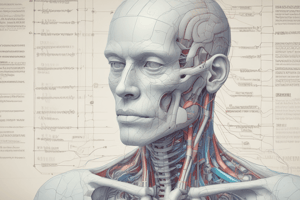Podcast
Questions and Answers
Match the following medical terms with their definitions:
Match the following medical terms with their definitions:
lapar/o = Abdomen albumin/o = Albumin, protein calc/i = Calcium creatin/o = Creatinine glycos/o = Sugar
What does the suffix '-centesis' mean?
What does the suffix '-centesis' mean?
Surgical puncture to remove fluid
What does the term 'hemat/o' refer to?
What does the term 'hemat/o' refer to?
Blood
What does '-otomy' mean?
What does '-otomy' mean?
What is the process referred to by '-graphy'?
What is the process referred to by '-graphy'?
What does the term 'son/o' refer to?
What does the term 'son/o' refer to?
What does '-scopy' mean?
What does '-scopy' mean?
What does 'radi/o' refer to?
What does 'radi/o' refer to?
What does '-uria' refer to?
What does '-uria' refer to?
What does 'phleb/o' refer to?
What does 'phleb/o' refer to?
What is a 'speculum' used for?
What is a 'speculum' used for?
The imaging technique that produces multiple cross-sectional images using x-radiation is ___________.
The imaging technique that produces multiple cross-sectional images using x-radiation is ___________.
Drug _________ is when the body has become accustomed to a medication after being on it for a length of time.
Drug _________ is when the body has become accustomed to a medication after being on it for a length of time.
The diagnostic technique __________ creates images of deep body structures by recording the echoes of pulses of sound waves.
The diagnostic technique __________ creates images of deep body structures by recording the echoes of pulses of sound waves.
The presence of calcium in the urine is known as _________.
The presence of calcium in the urine is known as _________.
A _________ test is used to identify high levels of inflammation within the body.
A _________ test is used to identify high levels of inflammation within the body.
In the _________ position, the patient is lying on the back with the knees bent.
In the _________ position, the patient is lying on the back with the knees bent.
A _________ is an abnormal sound heard during auscultation of an artery.
A _________ is an abnormal sound heard during auscultation of an artery.
The presence of pus in the urine is called ____________.
The presence of pus in the urine is called ____________.
What does CT stand for in medical imaging?
What does CT stand for in medical imaging?
What does the term 'idiosyncratic' mean in the context of drug reactions?
What does the term 'idiosyncratic' mean in the context of drug reactions?
______________ tomography combines tomography with radionuclide tracers to produce enhanced images.
______________ tomography combines tomography with radionuclide tracers to produce enhanced images.
A substances that does not allow x-rays to pass through is described as being _____________.
A substances that does not allow x-rays to pass through is described as being _____________.
When film is placed within the mouth and exposed by a camera positioned next to the cheek, this is called _____________ radiography.
When film is placed within the mouth and exposed by a camera positioned next to the cheek, this is called _____________ radiography.
A _____________ drug is sold under the name given by the manufacturer.
A _____________ drug is sold under the name given by the manufacturer.
What is auscultation?
What is auscultation?
What is the function of a sphygmomanometer?
What is the function of a sphygmomanometer?
Flashcards are hidden until you start studying
Study Notes
Medical Terminology Chapter 15: Key Terms
- Lapar/o refers to the abdomen
- Albumin/o refers to albumin, a type of protein
- Calc/i refers to calcium
- Creatin/o refers to creatinine
- Glycos/o refers to sugar
- Hemat/o refers to blood
- Phleb/o refers to vein
- Radi/o refers to radiation
- Son/o refers to sound
- -centesis refers to surgical puncture to remove fluid
- -otomy refers to surgical incision
- -graphy refers to the process of producing a picture or record
- -scopy refers to direct visual examination
- -uria refers to urine
Medical Terminology Chapter 15: Diagnostic Techniques
- Computed Tomography (CT) produces cross-sectional views
- X-rays produce views in only one direction
- Centesis refers to the removal of fluid for diagnostic purposes
- Fluoroscopy uses a luminous fluorescent screen
- MRI uses radio waves and a magnetic field
- Ultrasonography creates images of deep body structures by recording the echoes of pulses of sound waves
- Positron Emission Tomography (PET) combines tomography with radionuclide tracers to produce enhanced images of selected body organs or areas
Medical Terminology Chapter 15: Medical Terms
- Hypnosis is a type of therapy that involves focused concentration and narrowed attention
- Speculum is a device used to enlarge the opening of any body canal or cavity
- Tolerance refers to the body's adaptation to a medication, requiring higher doses to achieve the desired effect
- Calciuria refers to the presence of calcium in the urine
- Pyuria refers to the presence of pus in the urine
- Bruit refers to an abnormal sound heard during auscultation of an artery
- Dorsal recumbent refers to the position of lying on the back with the knees bent
Medical Terminology Chapter 15: Medical Devices
- Sphygmomanometer is used to measure blood pressure
- Stethoscope is used for auscultation, listening to sounds within the body
Studying That Suits You
Use AI to generate personalized quizzes and flashcards to suit your learning preferences.




